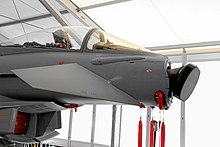
Back صفيف مسح إلكتروني نشط Arabic Активна фазирана антенна решетка Bulgarian Matriu d'escaneig electrònic actiu Catalan Active electronically scanned array Danish Active Electronically Scanned Array German آرایه اسکن الکترونیکی فعال Persian Aktiivinen elektronisesti keilaava tutka Finnish Aktivni elektronički upravljani antenski niz Croatian Active electronically scanned array Italian アクティブ・フェーズドアレイ・アンテナ Japanese
This article needs additional citations for verification. (April 2015) |

An active electronically scanned array (AESA) is a type of phased-array antenna, which is a computer-controlled antenna array in which the beam of radio waves can be electronically steered to point in different directions without moving the antenna.[1] In the AESA, each antenna element is connected to a small solid-state transmit/receive module (TRM) under the control of a computer, which performs the functions of a transmitter and/or receiver for the antenna. This contrasts with a passive electronically scanned array (PESA), in which all the antenna elements are connected to a single transmitter and/or receiver through phase shifters under the control of the computer. AESA's main use is in radar, and these are known as active phased-array radar (APAR).
The AESA is a more advanced, sophisticated, second-generation of the original PESA phased-array technology. PESAs can only emit a single beam of radio waves at a single frequency at a time. The PESA must utilize a Butler matrix if multiple beams are required. The AESA can radiate multiple beams of radio waves at multiple frequencies simultaneously. AESA radars can spread their signal emissions across a wider range of frequencies, which makes them more difficult to detect over background noise, allowing ships and aircraft to radiate powerful radar signals while still remaining stealthy, as well as being more resistant to jamming. Hybrids of AESA and PESA can also be found, consisting of subarrays that individually resemble PESAs, where each subarray has its own RF front end. Using a hybrid approach, the benefits of AESA (e.g., multiple independent beams) can be realized at a lower cost compared to pure AESA.
- ^ The Insane Engineering of the F-35B, 28 January 2023, retrieved 2024-02-16